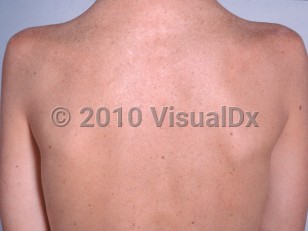Cockayne syndrome in Child
Synopsis

An early finding in patients with CS is growth retardation followed by deafness, loss of subcutaneous fat, and eventually cachexia, giving this syndrome its characteristic physical stigmata of a "cachectic dwarf."
Common additional findings include cataracts, progressive pigmentary retinopathy, dental caries, photosensitivity, and neurodevelopmental changes including white matter involvement. Early presentation with cataracts (ie, prior to age 3) in patients with CS seems to be associated with a more severe phenotype. Cause of death in patients with CS is variable. The leading cause of death is respiratory infection.
CS, like xeroderma pigmentosum (XP) and trichothiodystrophy, is a nucleotide excision repair disorder. In contrast to XP, skin cancers on sun-exposed areas are not observed in patients with CS. However, a dozen affected patients with clinical features of both CS and XP have been described and these patients are at high risk for the development of cutaneous neoplasms due to failure of DNA excision repair gene.
Codes
Q87.19 – Other congenital malformation syndromes predominantly associated with short stature
SNOMEDCT:
21086008 – Cockayne syndrome
Look For
Subscription Required
Diagnostic Pearls
Subscription Required
Differential Diagnosis & Pitfalls

Subscription Required
Best Tests
Subscription Required
Management Pearls
Subscription Required
Therapy
Subscription Required
References
Subscription Required
Last Updated:01/12/2022

